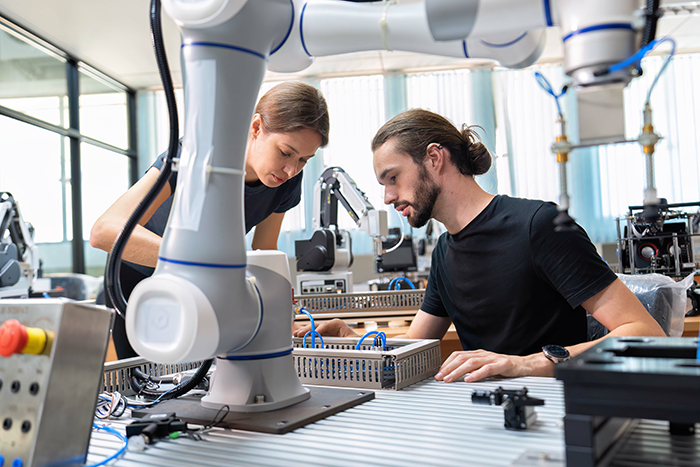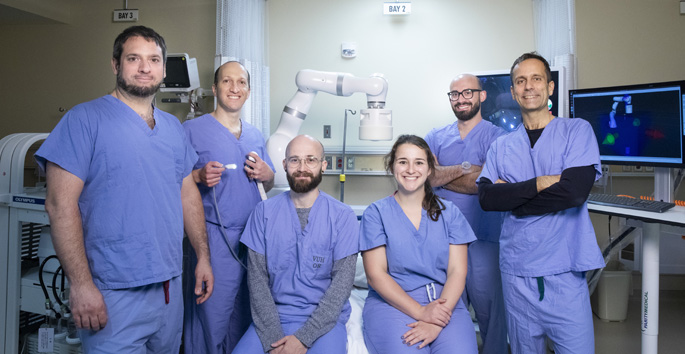
Health care is, at its core, human-centered; however, patients and providers are finding that artificial intelligence (AI) is becoming more and more present in all aspects of health. Whether it’s how we navigate large swaths of data, diagnose ailments or conduct complex surgical interventions, the medical field has benefited greatly from today’s rapidly evolving technological landscape. This past year alone has seen exponential growth in machine learning and AI; we can (and should) expect the rate of scientific advancements to continue increasing over the next couple of years.
When the only constant is change, it’s important to anticipate and adapt. And this is especially true in regards to the future of robotic surgery. Let’s explore some of the current and predicted trends in the field of surgery and intervention — and how engineers can prepare.
What is Robotic Surgery?
First, let’s level-set. Often referred to as robot-assisted surgery, robotic surgery is a type of surgery in which doctors perform complex procedures through the use of robotics to achieve a higher level of precision, flexibility, and control than what is possible with conventional techniques. Robotic surgery can be used in minor medical procedures as well as critical open surgical procedures.
Robotic surgery includes either small hand-held or robot–arm-held surgical tools that make tiny incisions to accomplish both routine and complex medical procedures. Robotic surgery is often less invasive than conventional surgeries, which results in shorter recovery times, fewer opportunities for scarring, milder postoperative pain and lower risk of infection.
3 Upcoming Trends in the Future of Robotic Surgery
These trends are based on current advancements and projections. The field of robotic surgery is continuously evolving; unforeseen trends might emerge within the next five years to change these predictions entirely.
Until then, here are three trends that will change the future of robotic surgery.
Trend 1: Miniaturization and Micro-robotics
One of the benefits of robotic surgery is how minimally invasive it is. However, engineers aim to make it even less invasive by creating robots and robotic systems at a microscopic scale. Miniaturized robots (microbots) will be smaller, faster, and more efficient than traditional robots, and they’ll have a range of applications: surgery, of course, but also assisting in drug delivery and targeted therapies to fight cancer.
Robots (of any size and shape) are devices that work in an uncertain environment — i.e., they adapt to their surroundings and move around to achieve a specific goal.
One of the most fundamental challenges in clinical micro-robotics is the environment since micro-robotic systems are sensitive to temperature, humidity, and surface chemistry. That’s not to mention the complexity that the environment of the human body presents with its ever-changing physiological conditions (soft tissue vs. blood) and biological events.

A Vanderbilt Institute for Surgery and Engineering (VISE) research team is conducting the first phase 1 clinical trial of a magnetic, flexible endoscope that has the potential to provide a safer alternative to standard colonoscopy, particularly for individuals with inflammatory bowel disease (IBD). Keith Obstein, MD, MPH, professor of Medicine at VUMC and professor of mechanical engineering at Vanderbilt University, is the principal investigator.
Engineers are working to not only create microbots that can function in the body but ones that are “intelligent” and can run themselves. Engineers expect that miniaturization and micro-robotics will decrease invasiveness, promote efficient surgical care and reduce the surgical footprint in procedures like prostatectomies, laparoscopies, nephrectomies and more.
Trend 2: Artificial Intelligence (AI) and Machine Learning
Experts anticipate that the integration of AI and machine learning algorithms into robotic surgery will play a more prominent role in the future. These technologies can assist in real-time decision-making, improve surgical planning and enhance the precision of robotic procedures.
For example, surgical margins play a large part in achieving favorable ontological outcomes. Normally, surgeons rely on intraoperative frozen-section pathology to determine the status, which takes time and impedes operating room efficiency. But with machine learning and advancements in spectroscopy, surgeons could start providing real-time SM assessment.
That’s just one example of many. Over the next few years, surgical procedures that are driven by artificial intelligence, machine learning, natural language processing and computer vision are predicted to grow and will greatly aid in the future of robotics and AI in surgery.
Trend 3: Telepresence in Surgery and Global Translation
In today’s increasingly remote world, the healthcare field is also expected to experience more trends related to virtual care, treatment and monitoring. Remote surgery, also referred to as telesurgery, telepresence or telerobotic surgery, will likely advance further, allowing surgeons to remotely perform surgeries on patients in different geographic locations.
This has huge implications; many rural areas of the United States lack access to basic healthcare providers, let alone complex surgical resources. Telepresence and remote surgery could enhance access to high-quality health care and improve overall health outcomes. It’s also useful to note that telepresence can be used for mentoring, as well, so that highly skilled surgeons can provide real-time guidance and technical assistance in surgical procedures.
There are still many challenges with which to contend: time lag, the cost of robotic systems, affordable high-speed networks worldwide, and cybersecurity threats, to name a few. However, engineers are working to make this approach to healthcare delivery a reality.
An alternative solution is to conceptualize revolutionary new ways to train more surgeons and translate it to a “wider swath of the global population”! Vanderbilt engineers are designing a cutting-edge simulator that will draw on augmented reality, machine learning, soft-tissue modeling, eye-tracking technology and assistive (haptic) force feedback to make training more effective for new users. You could potentially be one of them.
Join the Future of Healthcare Technology at Vanderbilt University School of Engineering
At Vanderbilt University School of Engineering, we now offer a respected master of engineering in surgery and intervention that is uniquely designed to create a new cadre of engineers capable of creating, developing and translating systems, devices and algorithms designed to facilitate surgical/interventional processes and their outcomes.
We invite you to take this valuable opportunity to transform the future of healthcare technology by obtaining this unique master of engineering in surgery and intervention. You can jumpstart your next academic journey at Vanderbilt University by requesting more information.
You may also start your online application or contact the program director today.




